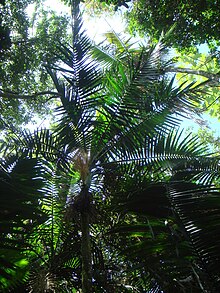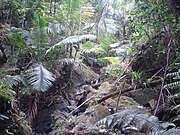Prestoea acuminata var. montana
| Prestoea acuminata var. montana | |
|---|---|

| |
| Scientific classification | |
| Kingdom: | Plantae |
| Clade: | Tracheophytes |
| Clade: | Angiosperms |
| Clade: | Monocots |
| Clade: | Commelinids |
| Order: | Arecales |
| Family: | Arecaceae |
| Genus: | Prestoea |
| Species: | |
| Variety: | P. a. var. montana
|
| Trinomial name | |
| Prestoea acuminata var. montana (Graham) A.J.Hend. & Galeano
| |
| Synonyms[1] | |
| |
Prestoea acuminata var. montana (vernacular English: Sierran palm;[2][3] vernacular Spanish: palma de sierra[4]) is a perennial palm in the family Arecaceae.
Description
[edit]A palm with a thin and tall stipe and a uniform diameter, reaching heights of 45 feet.
Distribution
[edit]It is found throughout the Greater Antilles as well as the Lesser Antilles of the Caribbean.
Habitat
[edit]Generally found in mountains of up to 1,300 feet (400 m) high.[5] It grows in the forest of creeks in the mountains, and on the steep slopes of the highest peaks in Puerto Rico. It is also found in Toro Negro State Forest, in the Puerto Rico Cordillera Central.[4] According to studies in the Luquillo Mountains, this palm also is associated with landslides.[6]
Uses
[edit]The fruit is the favorite food of the Puerto Rican parrot.[7]
Taxonomy
[edit]The plant was first described as Euterpe montana and was later transferred to the genus Prestoea.[8]
Prestoea: generic name in honor of Henry Prestoe (1842–1923), English botanist and traveler, who collected the plant in Trinidad.[9]
montana: from the Latin, meaning "from the mountain".[10]
Gallery
[edit]References
[edit]- ^ "Prestoea acuminata var. montana (Graham) A.J.Hend. & Galeano". Plants of the World Online. Royal Botanic Gardens, Kew. 2023. Retrieved 17 March 2023.
- ^ Prestoea montana (Graham) G. Nicholson; Taxonomic Serial No.: 42460. ITIS Report. Taxonomic Serial No.: 42460. Integrated Taxonomic Information System. White House Subcommittee on Biodiversity and Ecosystem Dynamics. USGS Reston, VA. Retrieved 5 September 2013.
- ^ Prestoea acuminata (Willd.) H.E. Moore var. montana (Graham) A. Hend. & G. Galeano: Sierran palm. USDA. Natural Resources Conservation Service. Retrieved 5 September 2013.
- ^ a b Bosques de Puerto Rico: Bosque Estatal de Toro Negro. Archived 2015-08-07 at the Wayback Machine Hojas de Nuestro Ambiente. July 2008. [Publication/Issue: P-030] Puerto Rico Department of Natural and Environmental Resources. Retrieved 5 September 2013.
- ^ Miner Solá, E. Árboles de Puerto Rico y exóticos. Puerto Rico. 3rd edition. ISBN 0-9633435-8-0. 2000.
- ^ Guariguata, M.R. (1990). "Landslide disturbance and forest regeneration in the Upper Luquillo mountains of Puerto Rico". Journal of Ecology. 78 (3): 814–832. doi:10.2307/2260901. JSTOR 2260901.
- ^ Mowbray, Alan M. 2002. Bosque Nacional del Caribe Guía Interpretativa de Palo Colorado. Puerto Rico:Servicio Forestal de los Estados Unidos, Bosque Nacional del Caribe
- ^ Prestoea montana in Tropicos
- ^ John Dransfield, Natalie Uhl, Conny Asmussen-Lange, William Baker, Madeline Harley and Carl Lewis. Genera Palmarum: The Evolution and Classification of Palms. Published by Kew, in association with the International Palm Society and the L.H. Bailey Hortorium, Cornell University. August 2008.
- ^ Archibald William Smith A Gardener's Handbook of Plant Names: Their Meanings and Origins, p. 239, at Google Books
Bibliography
[edit]- Anonymous. 1986. List-Based Rec., Soil Conservation Service, U.S.D.A. Database of the U.S.D.A., Beltsville.
- T. J. Killeen, E. García Estigarribia & S. G. Beck. (eds.) 1993. Guía Árb. Bolivia 1–958. Herbario Nacional de Bolivia & Missouri Botanical Garden. Editorial Quipus srl., La Paz, Bolivia. 1993.
External links
[edit] Media related to Prestoea montana at Wikimedia Commons
Media related to Prestoea montana at Wikimedia Commons Data related to Prestoea acuminata var. montana at Wikispecies
Data related to Prestoea acuminata var. montana at Wikispecies
See also
[edit]Relationship with inhabiting frog Common coquí: Eleutherodactylus coqui




